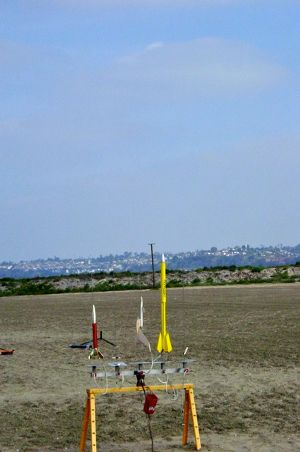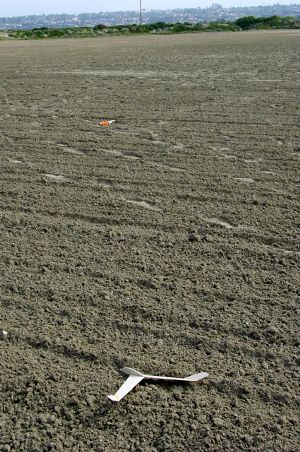| Construction Rating: | starstarstarstarstar_border |
| Flight Rating: | starstarstarstarstar |
| Overall Rating: | starstarstarstarstar_border |
| Manufacturer: | Semroc  |

Brief:
This is a pod-boosted glider. The unique features include a design that is essentially a flying wing, and forward
canard fins on the pod which are adjustable to give a vertical boost.
Construction:
This is a reproduction of an old Estes boost-glider, kit number K-34. It includes all of the parts of the original,
with some substantial improvements. All of the balsa parts are laser-cut from high quality material.
Included are:
- 1 Balsa nose cone
- 1 BT-20 body tube
- 1 Screw eye
- 1 Engine hook (original Estes style - I like this)
- 1 Wooden dowel 1/8"x 1"
- 1 Rubber (!) Shock cord 1/8"x 18"
- 1 Launch lug
- 1 Aluminum hinge material
- 1 Lead weight (!)
- 1 Parachute kit
- Balsa wings, body, canards
- 1 Pattern sheet
- 1 Decal sheet
 One of the unique features of Semroc's "xKit" series is that they do not include
any kind of instructions. They do provide url's to a couple of places where the original instructions for this kit can
be found. I found two scans. Both were complete. One was in color, complete with coffee stains.
One of the unique features of Semroc's "xKit" series is that they do not include
any kind of instructions. They do provide url's to a couple of places where the original instructions for this kit can
be found. I found two scans. Both were complete. One was in color, complete with coffee stains.
The old instructions were...old. Modern rocket kit instructions, now in the days of desktop publishing, are pretty well done with the illustrations matching the instructions in close proximity. I did not feel that the illustrations in these instructions were particularly helpful. The written instructions were adequately detailed for me to figure out what to do with all the parts.
There is room for modifying the order of assembly. You can usually go from glider to booster and back again to accommodate drying times.
I was originally intimidated when I found out I had to bend the outboard winglets myself. As it turns out, it was straightforward. I don't think that yellow carpenter's glue wets the wood as much as white glue. I let the glue sit for a few minutes, but the wood was still pretty stiff. With patience and strategic blocking I was able to get the 45 degree angle without breaking the tips off. The instructions did not say to do so, but I sanded the bottom of the midline V joint of the wing a little flat before gluing it to the plane body to give a better glue surface.
Carving out the hollows for the lead weight and the pin was made particularly easy by partial laser cuts on the inside of the body halves. For some reason there are not corresponding cuts in the pod pylon to tell you where to cut out the recess for the pin. This would be nice because the angle has to match the angle of the pin receiving hole on the glider.
The canards in the original kit are made from eight pieces of wood. In this kit the fixed and movable parts are stuck together, with a partial laser cut where they will be separated. On my first canard I separated these, then followed the instructions on constructing the canard. As I was struggling with aligning the fixed and movable parts, I realized that I could have done this without separating them, then cut a V notch out along the laser line to let them move once I was done. This made the second canard quite a bit easier.
I found that the aluminum hinge material was thin enough to crush into the balsa so that the two halves of each canard could be glued together all over their opposing wood surfaces. I used a woodworker's vise to apply even pressure.
An important note to people who tend to do things without instructions. The canards do not go on the pod 90 degrees away from the pylon. They are 100 degrees on either side. Use the tube marking guide.
Finishing:
There is another unique feature of this glider. The instructions have you sand a funky parallelogram airfoil shape
into the wing. It is not particularly difficult, but care must be taken not to break any of the joints while sanding. I
read another reviewer's comment about this, but decided to do the sanding after wing construction so I could review the
recommended procedure. You might be able to do this before wing construction, but the angle of the parallelogram
changes at the winglet, so it might be difficult to make that change with a sanding block if the wing weren't bent yet.
I sanded all the surfaces smooth to 220 grit and left it unpainted for the initial flights.
Construction Rating: 4 out of 5
Flight:
I trimmed out the glider first. Like the first reviewer I needed about 3/4 of the lead block, and I taped it in for
the flight.
I set the canards according to the illustration in the instructions, and did not have to alter it at all. All three boosts were very straight up.
Even though the manufacturer only lists two motors for this kit, I decided to go out on a limb. (I didn't have any of the recommended motors)
First flight Quest A6-4: Straight up, arced over. Delay too long. Good recovery. Glide was a tight spiral. I would like to trim this to a lazy spiral, but I left it alone because the wind was picking up.
Second flight Estes B6-2: Straight up, a little faster, not much higher, really. Two seconds was too short and robbed me of some altitude.
Third flight Estes A8-3: Straight up, a little lower. Perfect apogee ejection. Good glide.
Recovery:
There was a large crowd at the launch site. A lot of first-time attendees due to a Science Expo going on. Nobody else
was doing gliders. The dramatic appearance of this glider was eye-catching. It was a crowd pleaser. I am glad all three
flights went off without a hitch.
The HUGE ejection charge of the Quest A6-4 charred up the tube inside and out. No problem with the Estes charges for a change.

Flight Rating: 5 out of 5
Summary:
This was a very rewarding challenge to build. I do not agree with Semroc assigning this a skill level 1. I would say
skill level three because of all of the bending carving and shaping.
This is a visually dramatic model, and it flies very well.
Take care aligning the retaining pin and its hole on the glider body and pylon.
Glue the canard halves together with the aluminum hinge (under clamp/vise pressure) before cutting a wedge out at the hinge joint to allow them to be adjusted.
This model will fly well on motors not listed as officially recommended.
Overall Rating: 4 out of 5
Other:
In my opinion Semroc could improve this kit by reworking the instructions in modern form and either including them,
or making them available on their website.
Other Reviews
- Semroc Nighthawk (xKit) By Chan Stevens (November 8, 2008)
This is a reproduction of the 1968 Astron Nighthawk (K-34) boost glider. The canard-style glider, with "M" type dihedral, flies very well and is probably the best performing glider Semroc offers. The xKit concept is basically just a bag of parts, no instructions, though the header card offers a URL where the Jim Z scans are archived. The parts are excellent quality, and include: Pod ...
 |
 |